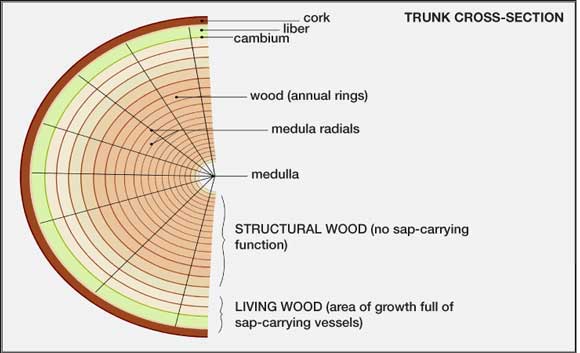Forestry Aspects
According to the classification of the Plant World, ligneous plants belong to the subdivisions of the Angiosperms (further subdivided into Monocotyledons and Dicotyledons) and Gymnosperms.
Wood is an organic material produced by a living and functioning organism, the tree, consisting of three morphologically and physiologically distinct parts: roots, trunk and foliage.
The term wood is commonly used to mean the internal part of the tree, the part which is used when the tree has been felled.
On the wall panels the three dimensional structure of wood from Coniferous and Broad-leaved trees is described.
Micro and Macromorphology of Wood
Wood is made up of cells with substantial walls, unequal in size and irregularly arranged, which respond to the needs of the living organism with different forms, dimensions, structures and arrangements.
In wood the following specialized cells and their respective tissues are mainly to be found: parenchymatous cells (forming the parenchymatous fabric), tracheides (forming the fibres of conifers), trachea (forming the vessels of broad-leaved trees) and sclerenchymatous cells (forming the actual fibres of the broad-leaved trees. (Panels on wall)
Coniferous wood has a simple constitution consisting almost entirely of tracheides (90%), long spindle shaped cells with the double function of support and conveying the sap, arranged radially and produced by the cambium. Because the elements of which it consists are particularly homogeneous (the tracheides), it is called “omoxilo”.
Conifers have resiniferous channels, except for one or two species (silver fir, cypress, yew and cedars) which however can appear as the result of a cut or trauma, recognisable for being concentrated in the same part.
The structure of broad-leaved trees is more complex as they have a greater variety of cells deriving from a greater specialization: cells for conveying liquids (vessels), cells with the mechanical function of resistance (fibres) as well as the parenchymatous and secreting cells also present in conifers.
The wood of both coniferous and broad-leaved trees grows by adding, between the bark and already existing wood, a new woody layer produced by a tissue called cambium which forms a kind of uninterrupted casing round the trunk. The liber or phloema, commomly called the bark, is the external part of the trunk with another outer “dead” part called ritidoma which protects the trunk from drought, insects, etc.
The liber also has an internal layer called the phloema which carries sap processed by the leaves to all parts of the trunk. When wood is put to use the liber is usually discarded.
Sometimes the difference between the two zones of the trunk – the inert inner part and the nutritional part – is not evident; then the wood is described as undifferentiated (e.g. spruce, birch, alder).
In other trees, on the contrary, the difference is visible to the eye and the wood is known as differentiated, that is made up of sapwood (external zone), pale coloured and light in weight, and duramen (the heart), with a richer colour, hard and heavy (e.g. larch, pines, oaks and walnut). In differentiated wood the cells in the middle part have not only lost their conveying function, but they also have internal deposits of substances like tannins which increase the wood’s resistance to alterations.
Characteristics of the wood’s appearance other than the colour (specifying whether fresh or seasoned, healthy or damaged) are visible to the naked eye:
Fabric: the size and distribution of constituent cell elements (e.g. box has a fine and regular fabric, chestnut, of irregular growth, has a rough and irregular fabric).
Veins: contrasting colours and compactness, due to alternating layers of Spring and later growth.
Brilliance: shininess of the medulla radials, particularly evident in beech, oak and plane trees.
In common trees of this region the trunk grows through the addition of successive rings in the cambium, inside the bark.
In temperate and cold climates where plants suspend their activity during low temperatures, in Winter the formation of wood is interrupted , in Spring it is more porous, lighter coloured and softer and finally becomes harder, darker and more compact in late Summer and Autumn.
This is why the rings alternate (as can be seen in the larch cross-section), each one corresponding to a year of growth and so, looking at the base of the plant it is possible to estimate its age.
Thus each ring has a dark line separating it from the light ring of the following year.
The width of the rings tells the story of the trees (dendrochronology).
Trees in the tropics, not having that interruption due to the cold or period of rest, never stop growing and so have no rings to distinguish their age.
Yearly rings are particularly visible in coniferous trees (spruce, pine and larch), more than in broad-leaved trees in which the line between one ring and another can be difficult to see (e.g. birch).
The regularity of rings, that is of their width, due to their rhythm of growth, indicates the quality of the wood. In temperate climates growth may be temporarily interrupted – e.g. due to drought or attacks by parasites – so there may be false rings, distinguishable from true ones as they don’t extend to the whole cross-section.
Any examination of wood requires an examination of the principal anatomic sections, that is a cross-section (perpendicular to the plant’s axis), a radial section (along the axis) and a tangential section (perpendicular to the radial section) which cuts across one or two growth rings.
The cross-section enables us to estimate the age of the tree from the rings and their width shows the rhythm of growth.
The radial section shows the shininess.
The tangential sections are often found in wood sawn into planks and show the veins and contrast between Spring and later growth.
These characteristics of micro/macromorphology can be seen in the wall panels and the wood specimen case in the centre of the room.



